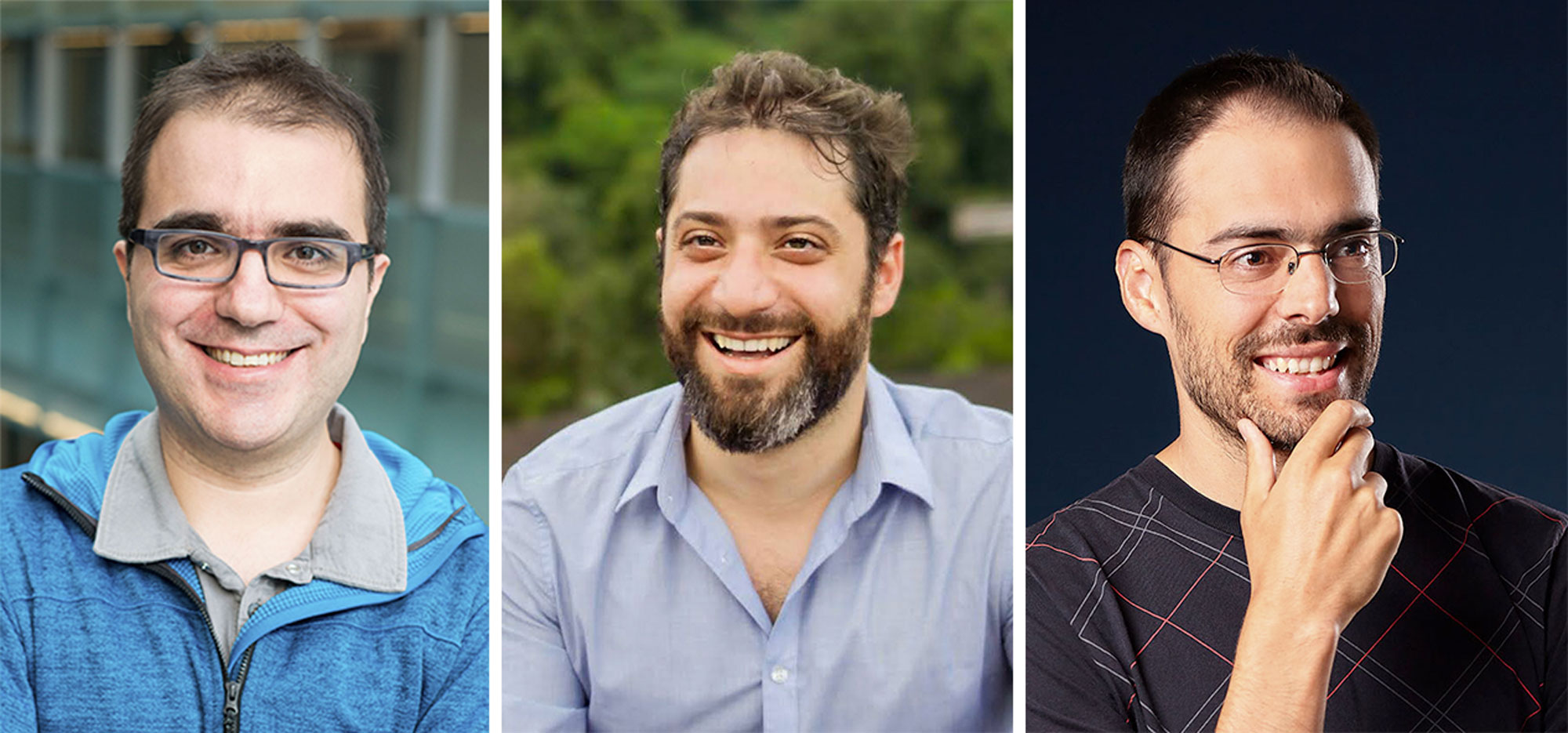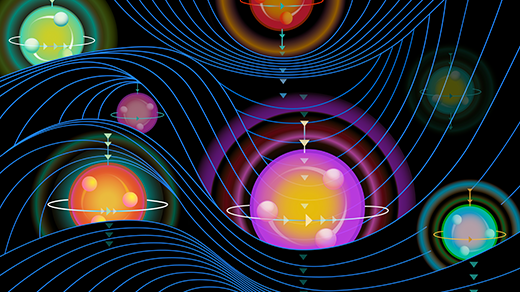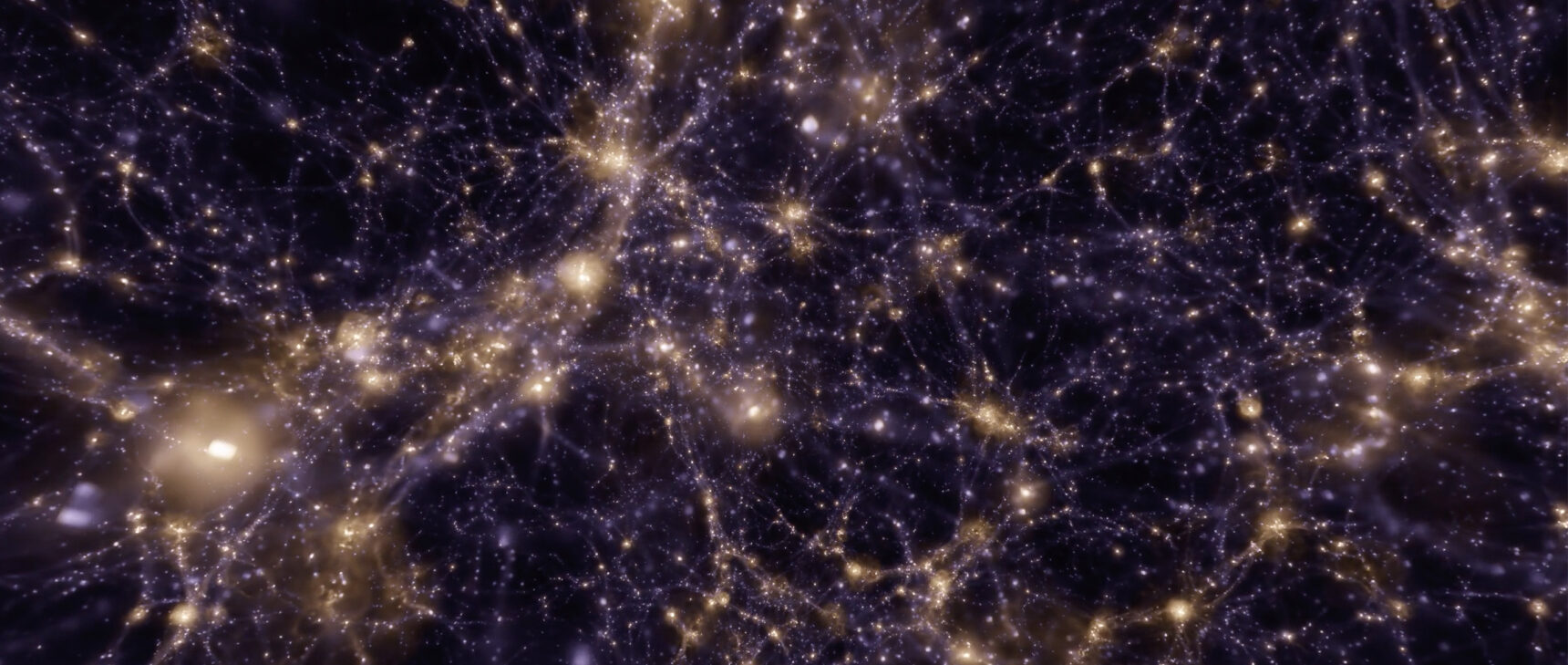In a Numerical Coincidence, Some See Evidence for String Theory

Quantum gravity researchers use $latex\alpha$ to denote the size of the biggest quantum correction to Einstein’s general relativity.
Dorine Leenders for Quanta Magazine
Introduction
Recently, three physicists calculated a number pertaining to the quantum nature of gravity. When they saw the value, “we couldn’t believe it,” said Pedro Vieira, one of the three.
Gravity’s quantum-scale details are not something physicists usually know how to quantify, but the trio attacked the problem using an approach that has lately been racking up stunners in other areas of physics. It’s called the bootstrap.
To bootstrap is to deduce new facts about the world by figuring out what’s compatible with known facts — science’s version of picking yourself up by your own bootstraps. With this method, the trio found a surprising coincidence: Their bootstrapped number closely matched the prediction for the number made by string theory. The leading candidate for the fundamental theory of gravity and everything else, string theory holds that all elementary particles are, close-up, vibrating loops and strings.
Vieira, Andrea Guerrieri of Tel Aviv University in Israel, and João Penedones of the Swiss Federal Institute of Technology Lausanne reported their number and the match with string theory’s prediction in Physical Review Letters in August 2021. Quantum gravity theorists have been reading the tea leaves ever since.
Some interpret the result as a new kind of evidence for string theory, a framework that sorely lacks even the prospect of experimental confirmation, due to the pointlike minuteness of the postulated strings.
“The hope is that you could prove the inevitability of string theory using these [bootstrap] methods,” said David Simmons-Duffin, a theoretical physicist at the California Institute of Technology. “And I think this is a great first step towards that.”

From left: Pedro Vieira, Andrea Guerrieri and João Penedones.
Gabriela Secara / Perimeter Institute for Theoretical Physics; Courtesy of Andrea Guerrieri; NCCR SwissMAP
Irene Valenzuela, a theoretical physicist at the Institute for Theoretical Physics at the Autonomous University of Madrid, agreed. “One of the questions is if string theory is the unique theory of quantum gravity or not,” she said. “This goes along the lines that string theory is unique.”
Other commentators saw that as too bold a leap, pointing to caveats about the way the calculation was done.
Einstein, Corrected
The number that Vieira, Guerrieri and Penedones calculated is the minimum possible value of $latex\alpha$ (alpha). Roughly, $latex\alpha$ is the size of the first and largest mathematical term that you have to add to Albert Einstein’s gravity equations in order to describe, say, an interaction between two gravitons — the presumed quantum units of gravity.
Einstein’s 1915 general theory of relativity paints gravity as curves in the space-time continuum created by matter and energy. It perfectly describes large-scale behavior such as a planet orbiting a star. But when matter is packed into too-small spaces, general relativity short-circuits. “Some correction to Einsteinian gravity has to be there,” said Simon Caron-Huot, a theoretical physicist at McGill University.
Physicists can tidily organize their lack of knowledge of gravity’s microscopic nature using a scheme devised in the 1960s by Kenneth Wilson and Steven Weinberg: They simply add a series of possible “corrections” to general relativity that might become important at short distances. Say you want to predict the chance that two gravitons will interact in a certain way. You start with the standard mathematical term from relativity, then add new terms (using any and all relevant variables as building blocks) that matter more as distances get smaller. These mocked-up terms are fronted by unknown numbers labeled $latex\alpha$, $latex\beta$, $latex\gamma$ and so on, which set their sizes. “Different theories of quantum gravity will lead to different such corrections,” said Vieira, who has joint appointments at the Perimeter Institute for Theoretical Physics in Waterloo, Canada, and the International Center for Theoretical Physics in Sao Paulo, Brazil. “So these corrections are our first way to tell such possibilities apart.”
In practice, $latex\alpha$ has only been explicitly calculated in string theory, and even then only for highly symmetric 10-dimensional universes. The English string theorist Michael Green and colleagues determined in the 1990s that in such worlds $latex\alpha$ must be at least 0.1389. In a given stringy universe it might be higher; how much higher depends on the string coupling constant, or a string’s propensity to spontaneously split into two. (This coupling constant varies between versions of string theory, but all versions unite in a master framework called M-theory, where string coupling constants correspond to different positions in an extra 11th dimension.)
Meanwhile, alternative quantum gravity ideas remain unable to make predictions about $latex\alpha$. And since physicists can’t actually detect gravitons — the force of gravity is too weak — they haven’t been able to directly measure $latex\alpha$ as a way of investigating and testing quantum gravity theories.
Then a few years ago, Penedones, Vieira and Guerrieri started talking about using the bootstrap method to constrain what can happen during particle interactions. They first successfully applied the approach to particles called pions. “We said, OK, here it’s working very well, so why not go for gravity?” Guerrieri said.
Bootstrapping the Bound
The trick of using accepted truths to constrain unknown possibilities was devised by particle physicists in the 1960s, then forgotten, then revived to fantastic effect over the past decade by researchers with supercomputers, which can solve the formidable formulas that bootstrapping tends to produce.
Guerrieri, Vieira and Penedones set out to determine what $latex\alpha$ has to be in order to satisfy two consistency conditions. The first, known as unitarity, states that the probabilities of different outcomes must always add up to 100%. The second, known as Lorentz invariance, says that the same laws of physics must hold from all vantage points.
The trio specifically considered the range of values of $latex\alpha$ permitted by those two principles in supersymmetric 10D universes. Not only is the calculation simple enough to pull off in that setting (not so, currently, for $latex\alpha$ in 4D universes like our own), but it also allowed them to compare their bootstrapped range to string theory’s prediction that $latex\alpha$ in that 10D setting is 0.1389 or higher.
Unitarity and Lorentz invariance impose constraints on what can happen in a two-graviton interaction in the following way: When the gravitons approach and scatter off each other, they might fly apart as two gravitons, or morph into three gravitons or any number of other particles. As you crank up the energies of the approaching gravitons, the chance they’ll emerge from the encounter as two gravitons changes — but unitarity demands that this probability never surpass 100%. Lorentz invariance means the probability can’t depend on how an observer is moving relative to the gravitons, restricting the form of the equations. Together the rules yield a complicated bootstrapped expression that $latex\alpha$ must satisfy. Guerrieri, Penedones and Vieira programmed the Perimeter Institute’s computer clusters to solve for values that make the two-graviton interactions unitary and Lorentz-invariant.
The computer spit out its lower bound for $latex\alpha$: 0.14, give or take a hundredth — an extremely close and potentially exact match with string theory’s lower bound of 0.1389. In other words, string theory seems to span the whole space of allowed $latex\alpha$ values — at least in the 10D place where the researchers checked. “That was a huge surprise,” Vieira said.
10-Dimensional Coincidence
What might the numerical coincidence mean? According to Simmons-Duffin, whose work a few years ago helped drive the bootstrap’s resurgence, “they’re trying to tackle a question [that’s] fundamental and important. Which is: To what extent does string theory as we know it cover the space of all possible theories of quantum gravity?”
String theory emerged in the 1960s as a putative picture of the stringy glue that binds composite particles called mesons. A different description ended up prevailing for that purpose, but years later people realized that string theory could set its sights higher: If strings are small — so small they look like points — they could serve as nature’s elementary building blocks. Electrons, photons and so on would all be the same kind of fundamental string strummed in different ways. The theory’s selling point is that it gives a quantum description of gravity: A graviton is a closed string, or loop, in its lowest-energy vibration mode, in which an equal number of waves travel clockwise and counterclockwise around the loop. This feature would underlie macroscopic properties of gravity like the corkscrew-patterned polarization of gravitational waves.
But matching the theory to all other aspects of reality takes some fiddling. To get rid of negative energies that would correspond to unphysical, faster-than-light particles, string theory needs a property called supersymmetry, which doubles the number of its string vibration modes. Every vibration mode corresponding to a matter particle must come with another mode signifying a force particle. String theory also requires the existence of 10 space-time dimensions for the strings to wiggle around in. Yet we haven’t found any supersymmetric partner particles, and our universe looks 4D, with three dimensions of space and one of time. Both of these data points present something of a problem.
If string theory describes our world, supersymmetry must be broken here. That means the partner particles, if they exist, must be far heavier than the known set of particles — too heavy to muster in experiments. And if there really are 10 dimensions, six must be curled up so small they’re imperceptible to us — tight little knots of extra directions you can go in at any point in space. These “compactified” dimensions in a 4D-looking universe could have countless possible arrangements, all affecting strings (and numbers like $latex\alpha$) differently.
Broken supersymmetry and invisible dimensions have led many quantum gravity researchers to seek or prefer alternative, non-stringy ideas. But so far the rival approaches have struggled to produce the kind of concrete calculations about things like graviton interactions that string theory can.
Some physicists hope to see string theory win hearts and minds by default, by being the only microscopic description of gravity that’s logically consistent. If researchers can prove “string universality,” as this is sometimes called — a monopoly of string theories among viable fundamental theories of nature — we’ll have no choice but to believe in hidden dimensions and an inaudible orchestra of strings.
To string theory sympathizers, the new bootstrap calculation opens a route to eventually proving string universality, and it gets the journey off to a rip-roaring start.
Other researchers disagree with those implications. Astrid Eichhorn, a theoretical physicist at the University of Southern Denmark and the University of Heidelberg who specializes in a non-stringy approach called asymptotically safe quantum gravity, told me, “I would consider the relevant setting to collect evidence for or against a given quantum theory of gravity to be four-dimensional and non-supersymmetric” universes, since this “best describes our world, at least so far.”
Eichhorn pointed out that there might be unitary, Lorentz-invariant descriptions of gravitons in 4D that don’t make any sense in 10D. “Simply by this choice of setting one might have ruled out alternative quantum gravity approaches” that are viable, she said.
Vieira acknowledged that string universality might hold only in 10 dimensions, saying, “It could be that in 10D with supersymmetry, there’s only string theory, and when you go to 4D, there are many theories.” But, he said, “I doubt it.”
Another critique, though, is that even if string theory saturates the range of allowed $latex\alpha$ values in the 10-dimensional setting the researchers probed, that doesn’t stop other theories from lying in the permitted range. “I don’t see any practical way we’re going to conclude that string theory is the only answer,” said Andrew Tolley of Imperial College London.
Just the Beginning
Assessing the meaning of the coincidence will become easier if bootstrappers can generalize and extend similar results to more settings. “At the moment, many, many people are pursuing these ideas in various variations,” said Alexander Zhiboedov, a theoretical physicist at CERN, Europe’s particle physics laboratory.
Guerrieri, Penedones and Vieira have already completed a “dual” bootstrap calculation, which bounds $latex\alpha$ from below by ruling out solutions less than the minimum rather than solving for viable $latex\alpha$ values above the bound, as they did previously. This dual calculation shows that their computer clusters didn’t simply miss smaller allowed $latex\alpha$ values, which would correspond to additional viable quantum gravity theories outside string theory’s range.
They also plan to bootstrap the lower bound for worlds with nine large dimensions, where string theory calculations are still under some control (since only one dimension is curled up), to look for more evidence of a correlation. Aside from $latex\alpha$, bootstrappers also aim to calculate $latex\beta$ and $latex\gamma$ — the allowed sizes of the second- and third-biggest quantum gravity corrections— and they have ideas for how to approach harder calculations about worlds where supersymmetry is broken or nonexistent, as it appears to be in reality. In this way they’ll try to carve out the space of allowed quantum gravity theories, and test string universality in the process.
Claudia de Rham, a theorist at Imperial College, emphasized the need to be “agnostic,” noting that bootstrap principles are useful for exploring more ideas than just string theory. She and Tolley have used positivity — the rule that probabilities are always positive — to constrain a theory called massive gravity, which may or may not be a realization of string theory. They discovered potentially testable consequences, showing that massive gravity only satisfies positivity if certain exotic particles exist. De Rham sees bootstrap principles and positivity bounds as “one of the most exciting research developments at the moment” in fundamental physics.
“No one has done this job of taking everything we know and taking consistency and putting it together,” said Zhiboedov. It’s “exciting,” he added, that theorists have work to do “at a very basic level.”
Editor’s note: Penedones and Vieira are members of the Simons Collaboration on the Nonperturbative Bootstrap, a research program supported by the Simons Foundation, which also funds this editorially independent magazine. Simons Foundation funding decisions have no influence on our coverage.



